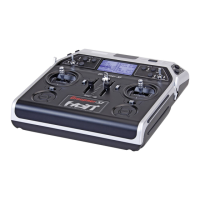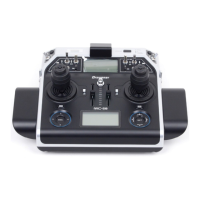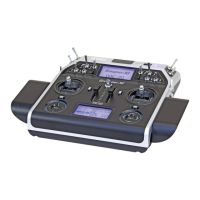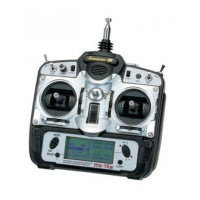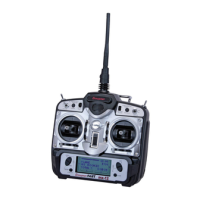59
Term denitions
into the control channels left and right aileron. Similarly:
for a helicopter set up as the “3Sv(2roll)” type, the
“Roll” control function is split into the control channels
left and right roll servo.)
The signal of this type of control channel can only be
further influenced by the settings entered in the »Servo
adjustment« menu (and in the »Tx. output swap«
menu, which is available in the
mc-20 HoTT trans-
mitter only); the signal then leaves the transmitter via
the RF module.
Once it arrives at the receiver, this signal may still be
modified by settings made in the »Telemetry« menu
before finally being applied as a control quantity for the
respective servo.
Mixer
The transmitter’s software contains a variety of mixer
functions. These can be used to apply one control
function to multiple servos or, conversely, to apply
multiple control functions to a single servo. Please look
over the numerous mixer functions in the text beginning
on page 165 of this manual.
Switches
The standard toggle switches, the 3-way switches and
both push-button switches can also be incorporated
into control programming. However, these switches
are generally intended for switching program options,
e. g. to start and stop timers, to switch mixers on and
off, or as a teacher/pupil switchover, etc. Each of these
switches can be assigned any number of functions.
Appropriate examples are detailed in the manual.
Control switches
Since it is very practical to have some functions auto-
matically switched on or off for a certain control’s posi-
tion (e. g. switch on/off of a stopwatch for acquisition
of model run time, automatic extension of spoilers and
other possibilities), four control switches have been
integrated into
mc-16 HoTT and mc-20 HoTT
software.
These software switches, designated “C1 … C4”, are
merely defined by virtue of their contact state along the
physical control’s course of travel by the touch of a key.
The switching action can be correlated to the physical
control’s travel direction by software.
Of course control switches can also be freely combined
with the aforementioned physical switches to solve
even more complex problems.
There is a series of instructive examples which make
this programming child’s play. Learn about this by tak-
ing advantage of the programming examples beginning
on page 280.
Logical switches
This function, which is available as standard on the
mc-20 transmitter only, allows two switches, control
switches and / or logical switches, or any combination
of the above, to be linked in an “AND” or “OR” circuit.
Eight logical switches “L1 … L8” can be programmed
in total; see page 144.
Fixed switches FXI and FX
This type of switch turns a function, e. g. a timer, per-
manently on (closed fixed switch) or off (open fixed
switch) or they can provide a fixed input signal for a
control function, e. g. FXI = +100 % and FX = -100 %.
For example, in flight phase programming, these fixed
switches can be used to switch a servo or speed con-
troller between two settings.

